Results 1 to 4 of 4
Thread: Jobs report an 'utter mess'...
Thread Information
Users Browsing this Thread
There are currently 1 users browsing this thread. (0 members and 1 guests)
-
01-08-2011, 12:43 AM #1Senior Member


- Join Date
- May 2007
- Location
- South West Florida (Behind friendly lines but still in Occupied Territory)
- Posts
- 117,696
Jobs report an 'utter mess'...
Friday, January 07, 2011 12:42 PM
BLS Job Report: December Nonfarm Payrolls +103,000, November Revision +32,000, October Revision +38,000; Workforce DROPS by 260,000
Following ADP's report of private-sector employment at +297,000, the BLS reported private sector employment at +113,000 and an overall nonfarm total of +103,000 well under expectations of about +175,000 jobs. However, there were substantial backward revisions to note.
Revisions
* November nonfarm payroll revised from +39,000 to +71,000 a gain of +32,000.
* November private payroll revised from +50,000 to +79,000, a gain of +29,000.
* October nonfarm payroll revised from +172,000 to +210,000 a gain of +38,000.
* October private payroll revised from +160,000 to +193,000, a gain of +33,000.
* Combined nonfarm payroll revision +70,000.
* Combined private payroll revision +62,000
If those back revisions were instead added into today's numbers, nonfarm payrolls would be +173,000 and private sector jobs at +175,000. Those would have been good, but not amazing numbers.
However, a better way of looking at things is via the revisions. We had a better than expected seasonal ramp of jobs in October followed by subpar job growth in November (even after the revisions), and subpar growth in December as well.
This is along the lines that I have suggested several times: limited hiring following seasonal retail hiring.
260,000 Drop Out of Work Force
The reported unemployment rate fell a substantial .4% to 9.4%. However, much of that that gain is a statistical mirage. The BLS reports a whopping 260,000 people dropped out of the work force. As a result the participation rate fell to a new low of 64.3%.
BLS December Report
Please consider the Bureau of Labor Statistics (BLS) December 2010 Employment Report.
The unemployment rate fell by 0.4 percentage point to 9.4 percent in December, and nonfarm payroll employment increased by 103,000, the U.S. Bureau of Labor Statistics reported today. Employment rose in leisure and hospitality and in health care but was little changed in other major industries.
Unemployment Rate - Seasonally Adjusted

Bear in mind, were it not for millions of people allegedly dropping out of the labor force over the last year, the unemployment rate would be over 11% right now.
Nonfarm Payroll Employment - Seasonally Adjusted
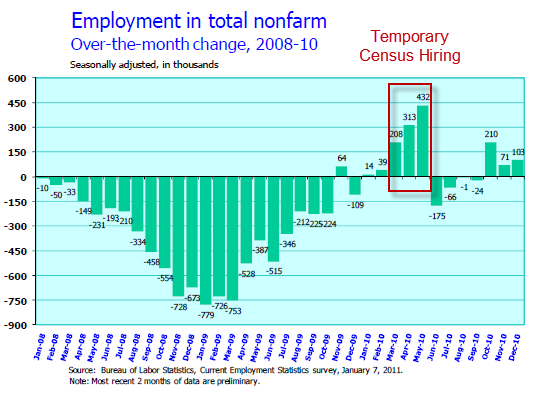
Note the effect of temporary census hiring earlier this year. For all the hype about the improving economy, there has only been one good jobs report all year, in October.

Establishment Data
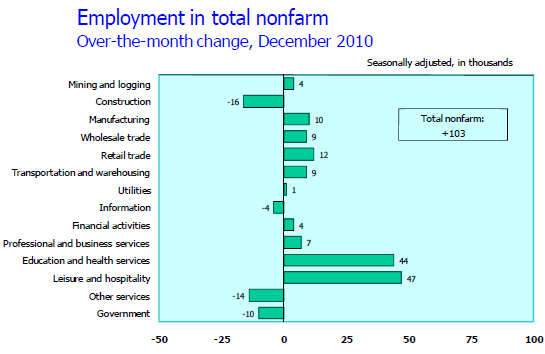
Index of Aggregate Weekly Hours
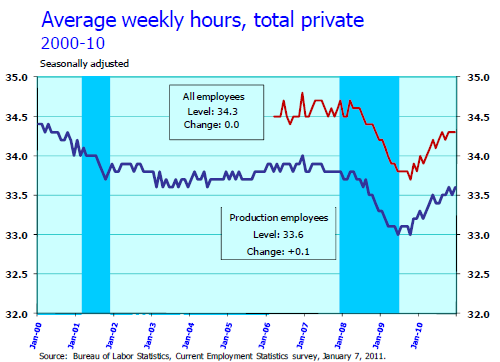
The average workweek for all employees on private nonfarm payrolls held at 34.3 hours in December. The manufacturing workweek for all employees declined by 0.1 hour to 40.2 hours, while factory overtime remained at 3.1 hours. The average workweek for production and nonsupervisory employees on private nonfarm payrolls increased by 0.1 hour to 33.6 hours.
In December, average hourly earnings for all employees on private nonfarm payrolls increased by 3 cents, or 0.1 percent, to $22.78. Over the past 12 months, average hourly earnings have increased by 1.8 percent. In December, average hourly earnings of private-sector production and nonsupervisory employees rose by 2 cents, or 0.1 percent, to $19.21.
BLS Birth-Death Model Black Box
For those unfamiliar with the birth/death model, monthly jobs adjustments are made by the BLS based on economic assumptions about the birth and death of businesses (not individuals).
Birth Death Model Revisions 2009

Birth Death Model Revisions 2010
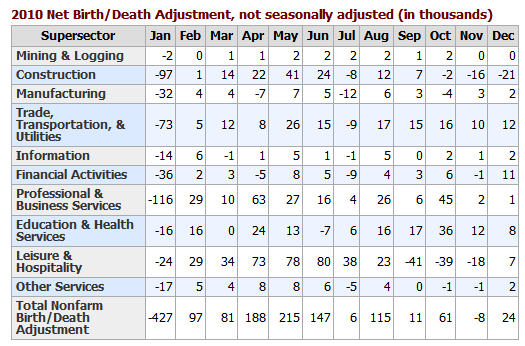
Birth-death adjustments remain in the solar system for an unprecedented four consecutive months. November was negative. I cannot recall the last negative number in any month but January or July.
Birth/Death Model Methodology
The big news in the BLS Birth/Death Model is the BLS is going to move to quarterly rather than annual adjustments.
Effective with the release of January 2011 data on February 4, 2011, the establishment survey will begin estimating net business birth/death adjustment factors on a quarterly basis, replacing the current practice of estimating the factors annually. This will allow the establishment survey to incorporate information from the Quarterly Census of Employment and Wages into the birth/death adjustment factors as soon as it becomes available and thereby improve the factors.
For more details please see Introduction of Quarterly Birth/Death Model Updates in the Establishment Survey
In recent years Birth/Death methodology has been so screwed up and there have been so many revisions that it has been painful to watch.
It is possible that the BLS model is now back in sync with the real world. Moreover, quarterly rather than annual adjustments can only help the process.
Please note that one cannot subtract or add birth death revisions to the reported totals and get a meaningful answer. One set of numbers is seasonally adjusted the other is not. In the black box the BLS combines the two coming out with a total. The Birth Death numbers influence the overall totals but the math is not as simple as it appears and the effect is nowhere near as big as it might logically appear at first glance.
Birth/Death assumptions are supposedly made according to estimates of where the BLS thinks we are in the economic cycle. Theory is one thing. Practice is clearly another as noted by numerous recent revisions.
Household Data

In the last year the civilian population rose by 1,965,000. Yet the labor force rose by a mere 518,000. Those not in the labor force rose by 1,447,000. In December alone, a whopping 260,000 people dropped out of the workforce. The one bright spot in the entire report: employment rose by 297,000.
Households Stats
* The number of unemployed persons decreased by 556,000 to 14.5 million in December, and the unemployment rate dropped to 9.4 percent.
* The number of long-term unemployed (those jobless for 27 weeks or more) was little changed at 6.4 million and accounted for 44.3 percent of the unemployed.
* The civilian labor force participation rate edged down in December to 64.3 percent, and the employment-population ratio was essentially unchanged at 58.3 percent.
* The number of persons employed part time for economic reasons (sometimes referred to as involuntary part-time workers) was essentially unchanged in December at 8.9 million. These individuals were working part time because their hours had been cut back or because they were unable to find a full-time job.
* About 2.6 million persons were marginally attached to the labor force in December, little different than a year earlier. (The data are not seasonally adjusted.) These individuals were not in the labor force, wanted and were available for work, and had looked for a job sometime in the prior 12 months. They were not counted as unemployed because they had not searched for work in the 4 weeks preceding the survey.
In January 2010 the number of people working part time for economic reason was 8.3 million. 12 months later the total has gone up by 631,000.
Table A-8 Part Time Status
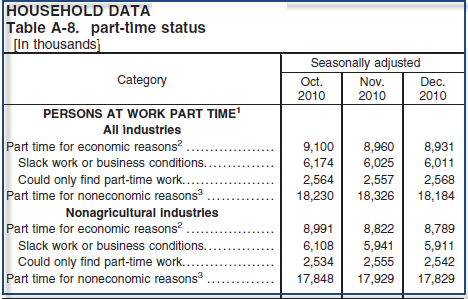
There are now 8,931,000 workers whose hours may rise before those companies start hiring more workers.
Table A-15
Table A-15 is where one can find a better approximation of what the unemployment rate really is.

Grim Statistics
The official unemployment rate is 9.4%. However, if you start counting all the people that want a job but gave up, all the people with part-time jobs that want a full-time job, all the people who dropped off the unemployment rolls because their unemployment benefits ran out, etc., you get a closer picture of what the unemployment rate is. That number is in the last row labeled U-6.
While the "official" unemployment rate is an unacceptable 9.4%, U-6 is much higher at 16.7%. Moreover, both the official rate and U-6 would be much higher were it not for huge numbers of people dropping out of the workforce.
Things are much worse than the reported numbers would have you believe.
Mike "Mish" Shedlock
http://globaleconomicanalysis.blogspot. ... nfarm.htmlJoin our efforts to Secure America's Borders and End Illegal Immigration by Joining ALIPAC's E-Mail Alerts network (CLICK HERE)
-
01-08-2011, 01:14 AM #2Senior Member


- Join Date
- May 2007
- Location
- South West Florida (Behind friendly lines but still in Occupied Territory)
- Posts
- 117,696
US jobs report an âutter messâ
By Robin Harding in Washington
Published: January 7 2011 13:57
Last updated: January 7 2011 19:16
Markets hoped that Decemberâs payroll report would mark a breakthrough for the US economyâs recovery, with a surge in private job creation towards 200,000 â a level that would finally put a dent in the unemployment rate.
Instead they got a murky mixture of a report, prompting one economist, Rob Carnell of ING Bank, to call it an âutter messâJoin our efforts to Secure America's Borders and End Illegal Immigration by Joining ALIPAC's E-Mail Alerts network (CLICK HERE)
-
01-08-2011, 03:19 AM #3Senior Member


- Join Date
- May 2007
- Location
- South West Florida (Behind friendly lines but still in Occupied Territory)
- Posts
- 117,696
Numbers Racket http://www.youtube.com/watch?v=WAbP0gdbfrg
Charlie McGrath ~ I love this guyJoin our efforts to Secure America's Borders and End Illegal Immigration by Joining ALIPAC's E-Mail Alerts network (CLICK HERE)
-
01-08-2011, 04:07 PM #4Airborne, I saw the initial projection, then the report of 297k new jobs, but completely missed the significance of employment vs household data. IMO getting a handle on this data is crucial. Lama Smith wants to develop support for a range of proposals by focusing on illegals and jobs. That's a great idea, but the 297k figure makes it look as if the emergency is ending.
 Originally Posted by AirborneSapper7
Originally Posted by AirborneSapper7
I've bookmarked this thread and will revisit it, but at the moment I'm seriously confused.
Really appreciate the top flight research, BTW.


 LinkBack URL
LinkBack URL About LinkBacks
About LinkBacks




 Reply With Quote
Reply With Quote

Long Beach Declares Public Health Emergency Due to Surprising...
05-04-2024, 07:58 PM in illegal immigration News Stories & Reports